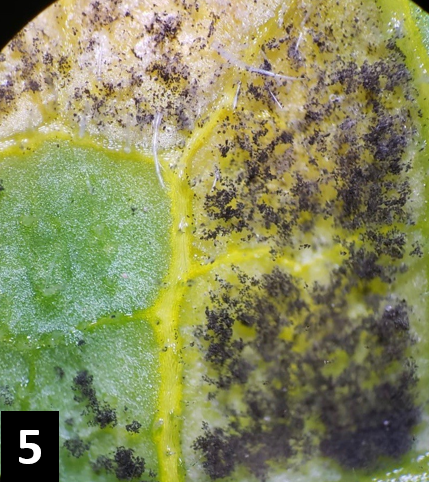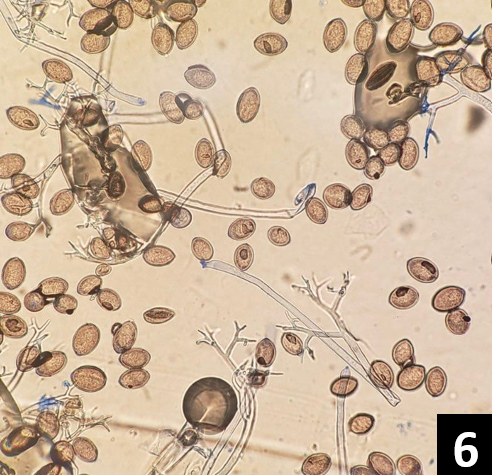First 2024 cucurbit downy mildew spores identified in air samples in Saginaw County
Growers are urged to scout cucumbers and melons and check the Downy Mildew News website for updates.

Cucurbit downy mildew spores have been verified in air samples from Saginaw County from the first week of June using a Burkard volumetric spore trap coupled with qPCR molecular analysis of the spore trap tape and verified with microscopy. Saginaw County is located on Michigan’s east side in the Thumb region and hosts vegetable production for the fresh and processing markets. The positive air samples from Saginaw County are the first confirmation of airborne downy mildew sporangia for the state in 2024. In Saginaw County, we detected Clade 2 of the cucurbit downy mildew pathogen spores in the air, which most commonly infect cucumber and melon.
A cucurbit downy mildew disease outbreak on cucumber (or other cucurbit) plants has not been reported in Michigan. The spore trapping network to detect downy mildew spores in the air has been established by our lab in several Michigan counties. Downy mildew spores have not been detected in air samples from other monitoring sites. We are watching all spore traps carefully for the detection of downy mildew spores in the air samples from Michigan’s cucumber production regions. Our spore trap webpage is updated with the latest results. Results from the spore traps are several days behind due to processing of the spore tapes.
We can distinguish between cucumber and hop downy mildew spores using molecular tools. Keeping an eye on the spore trap results across the state will be helpful in knowing when the cucumber downy mildew pathogen has been detected in the air samples from a particular production region. The cucurbit downy mildew pathogen does not overwinter in northern growing regions; the spores move from overwintering sites such as production greenhouses or the southern U.S. production regions via air currents. Visit the Downy Mildew News page for spore trap results and current downy mildew news.
This is about the time in Michigan’s growing season for the first occurrence of cucurbit downy mildew spores in air samples from the field. In other years, we have detected the first disease outbreak in a Michigan field around the first week of July. The detection of downy mildew spores in the air usually occurs a few days or a couple of weeks prior to a field outbreak. While it is concerning that an influx of sporangia has been detected, these sporangia must land on a suitable plant such as a cucumber or melon and then the weather conditions must allow the spores to germinate and infect.
The cucurbit downy mildew pathogen (Pseudoperonospora cubensis) prefers cooler temperatures and humid conditions. The weather earlier this growing season had been favorable for downy mildew disease (cooler temperatures and rain). While extremely hot temperatures are in the immediate forecast, which normally would stall the downy mildew pathogen, the recent storms favor disease development and pathogen spread. At this time, Michigan State University Extension recommends growers and scouts keep a close eye on cucumber and melon plantings that may have been established under low or high tunnels and scout frequently. A protective fungicide application may be considered now.
The use of recently developed molecular diagnostics coupled with microscopy ensures the accurate confirmation of this pathogen from our spore trap air samples. The cucurbit downy mildew sporangia detected in the air from Saginaw County may have originated from local/regional cucumber production greenhouses or from early field plantings of cucumbers and melons being grown in low/high tunnels. Elsewhere in the U.S., cucurbit downy mildew outbreaks in the field have been recently detected North Carolina and South Carolina.
We urge growers, scouts, consultants and Extension educators to monitor greenhouse cucumber production and early cucumber and melon field plantings that may be in high or low tunnels. Suspect samples should be submitted for a diagnosis. See instructions on how to submit samples.


It is very important that cucumber growers use proven downy mildew fungicides (shown below in alphabetical order). These fungicides were effective in our 2021, 2022 and 2023 research field plots and include:
- Elumin + chlorothalonil or mancozeb
- Omega (Orbus) + chlorothalonil or mancozeb
- Orondis Opti (chlorothalonil is part of the premix)
- Previcur Flex + chlorothalonil or mancozeb
- Ranman + chlorothalonil or mancozeb
- Zampro + chlorothalonil or mancozeb
Fungicides should be alternated so that resistance of the pathogen to the fungicide’s active ingredient does not develop. It is important that the fungicides be applied prior to the plants becoming infected. Waiting until the disease develops in the field before applying fungicides can lead to control failure and pathogen resistance. Currently, many of the state’s pickling cucumber crops are in early development. Downy mildew infection at this stage would likely hurt yields significantly. Downy mildew can infect the cotyledons of cucumbers and has been observed in previous years for the later season plantings.



 Print
Print Email
Email

